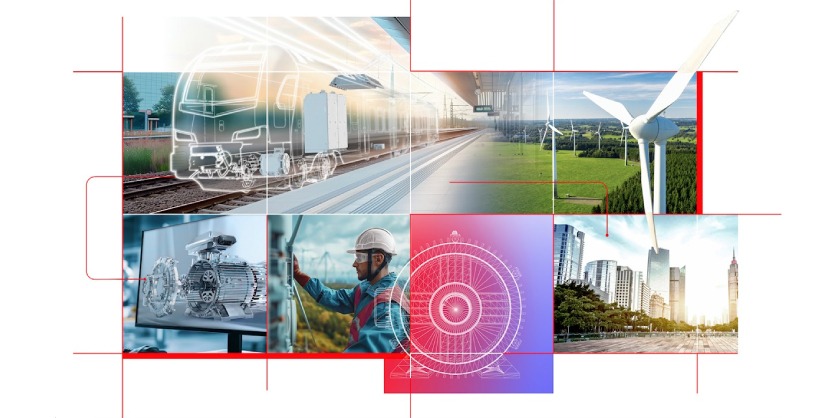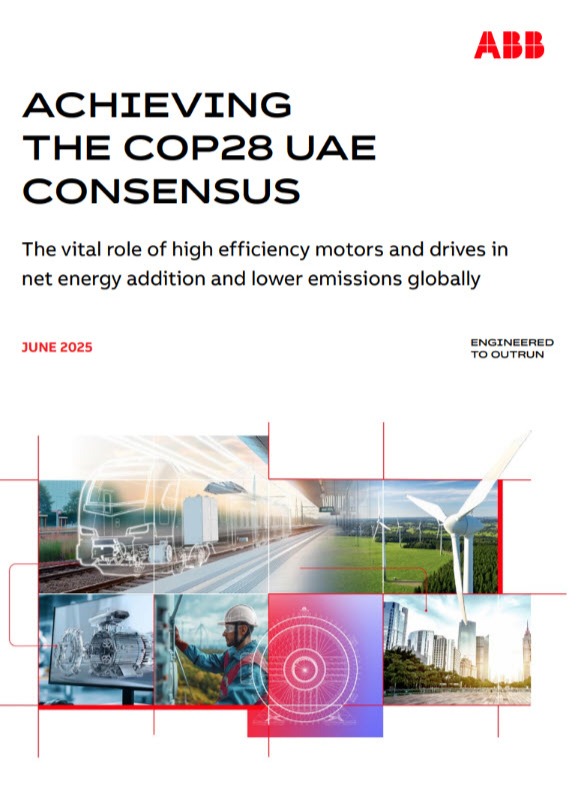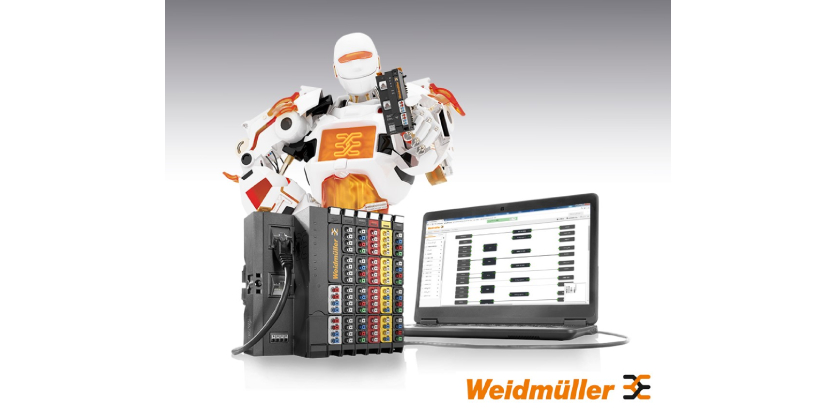The Time is Now: An Industrial Energy Efficiency Action Plan
June 13, 2025

- ABB Whitepaper, “Achieving the COP28 UAE Consensus – The vital role of high-efficiency motors, and drives in net energy addition and lower emissions globally”, calls for rapid steps on industrial energy efficiency amid surging energy demand and electricity use
- ABB leaders will champion scaled up action at International Energy Agency (IEA) Energy Efficiency Conference in Brussels
- Call for increased public and private investment alongside effective legislation to speed up adoption of energy efficient solutions
- High-efficiency motors, drives, and digital technologies are highlighted as the key solutions to help industry outrun leaner and cleaner
In a whitepaper released on June third, ABB has set out the scale of the challenge facing the global industrial sector and emphasizes the critical role of industrial energy efficiency in meeting rising energy demand while strengthening energy security & affordability and driving industrial competitiveness. With 45% of the world’s electricity converted by industrial electric motors into motion1, industrial energy efficiency is a part of the solution that cannot be overlooked.
Launched ahead of a meeting of global decisionmakers at the International Energy Agency’s 10th Annual Global Conference on Energy Efficiency in Brussels, on June 12-13, the whitepaper identifies the scale of untapped potential for energy efficiency in the industrial sector. The rapid adoption of higher-efficiency motors, pairing of motors with drives, insights from energy audits, and optimized digitalization & connectivity are identified as key targets for industry. Greater investment and clear regulation are also urgently needed to facilitate the scaling up of essential technologies to advance the energy transition.
In 2024, global energy demand grew by 2.2%, outpacing the global average over the last decade. Nearly 40% of this growth was driven by the industrial sector, while industrial electricity use increased by 4%2. Despite these significant increases, the energy efficiency of motors and drives has been neglected in comparison with other sustainable energy solutions.
In a clear action plan, ABB calls on policymakers to increase their cooperation with the private sector. Policymakers must encourage industries to adopt efficient technologies through incentives, subsidies, and tax breaks, addressing the growing unforeseen demands on energy grids from data centers and AI.
Erich Labuda, Division President, ABB Motion Services, said:
“Around the world, rising energy demand, climate pressure, and geopolitical instability are converging to create an urgent need for smarter energy use. Energy efficiency is one of the most powerful, yet underused, tools we have to address these global challenges. It reduces emissions, strengthens energy security, and boosts industrial resilience — all with technologies that are available today. Today we are proud to have produced a comprehensive whitepaper which outlines how we can put over 10% energy capacity back into the grid without trillions of dollars in new infrastructure costs.”
“Proven solutions including high-efficiency motors and drives are already delivering double-digit energy savings. With payback periods as short as seven months, the business case is clear. Now is the time to scale up. Our whitepaper highlights that doubling the rate of energy efficiency improvements to 4% annually until 2030 could avoid a third of the emissions reductions needed for Net Zero, equivalent to China’s annual energy consumption.”
“Energy efficiency isn’t an optional upgrade — it’s a critical one. Greater energy efficiency not only enhances energy independence but also spurs economic growth, making the adoption of these solutions a clear and sensible choice.”
The report demonstrates the scale of the impact energy efficient technology can have on industry, including rapid return on investment and more efficient operations for the long-term.
From November 2024 to May 2025, ABB screened over 10,500 industrial electric motor-driven systems. Among these, 5,900 were prioritized and appraised, identifying average energy savings of 43%, equivalent to approximately 941,000 MWh3 or the annual energy use of 91,715 US households4.
With over 300 million industrial electric motors in operation globally, adopting modern high-efficiency technologies can achieve significant energy and CO2 savings. There are a range of solutions which can deliver significant savings – IE3 motors achieve about 96% efficiency, IE4 motors go further and reduce energy losses by a further 15%, and IE5 motors are even more efficient with 20% lower losses than IE4. Correctly sizing motors for their applications in an industry context can further enhance industrial efficiency.
Even greater savings are possible with variable-speed drives (VSDs), which optimize motor operation by adjusting speed and torque to match load requirements, typically reducing power consumption by 25%. With only 25% of industrial motors currently using drives, there is a significant opportunity to cut global energy consumption by up to 10% through increased adoption of high-efficiency motors and drives.
To read the full Whitepaper, please click here

ABB is a global technology leader in electrification and automation, enabling a more sustainable and resource-efficient future. By connecting its engineering and digitalization expertise, ABB helps industries run at high performance, while becoming more efficient, productive and sustainable so they outperform. At ABB we call this ‘Engineered to Outrun’. Building on over 140 years of excellence and with more than 105,000 employees worldwide, ABB optimizes how things are manufactured, moved, powered and protected. The company’s shares are listed on the SIX Swiss Exchange (ABBN) and Nasdaq Stockholm (ABB). At the heart of the energy transition, ABB helps the world’s industries outrun – leaner and cleaner. www.abb.com
ABB Motion, a global leader in motors and drives, is at the core of accelerating a more productive and sustainable future. We innovate and push the boundaries of technology to contribute to energy efficient, decarbonizing and circular solutions for customers, industries and societies. With our digitally enabled drives, motors and services we support our customers and partners to achieve better performance, safety and reliability. To help the world’s industries outrun – leaner and cleaner, we deliver motor-driven solutions for a wide range of applications in all industrial segments. Building on over 140 years of domain expertise in electric powertrains, our more than 23,000 employees across 100 countries learn and improve every day. go.abb/motion
Endnotes
- IEA’s “Energy-Efficiency Policy Opportunities for Electric Motor-Driven Systems” report
- International Energy Agency, Global Energy Review 2025: Key Findings, 2025
- Data based on ABB Energy Appraisals performed between November 2024 and May 2025
- Green Power Equivalency Calculator | US E
Related Story
Research Reveals Energy Concerns Impacting Business Competitiveness, The Workforce and Decarbonization
Research shows that businesses around the world remain concerned about the impacts of energy security and prices, which could be a catalyst for a range of environmental, social and economic ripple effects. According to ABB Electrification’s Energy Insights survey1 of 2,300 leaders from small and large businesses across a range of sectors, 92 percent of respondents feel that the continuing instability of energy is threatening their profitability and competitiveness. Energy costs and insecurity are having a significant impact on the workforce with decreased investment in employees. Business leaders are also concerned about potential impacts of meeting their sustainability targets.





